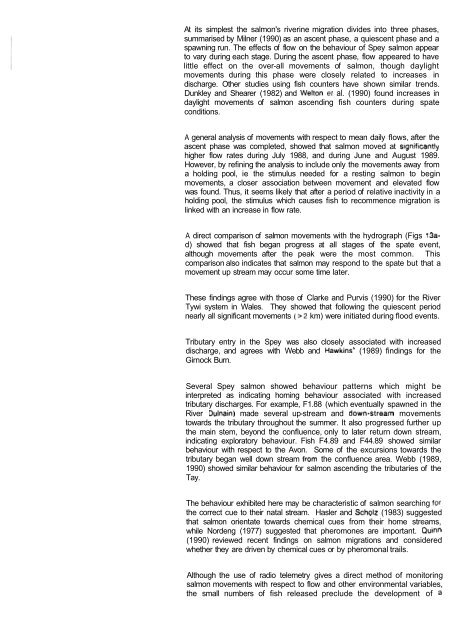( Salmo salar L.) in the River Spey as determined by
( Salmo salar L.) in the River Spey as determined by
( Salmo salar L.) in the River Spey as determined by
Create successful ePaper yourself
Turn your PDF publications into a flip-book with our unique Google optimized e-Paper software.
At its simplest <strong>the</strong> salmon's river<strong>in</strong>e migration divides <strong>in</strong>to three ph<strong>as</strong>es,<br />
summarised <strong>by</strong> Milner (1990) <strong>as</strong> an <strong>as</strong>cent ph<strong>as</strong>e, a quiescent ph<strong>as</strong>e and a<br />
spawn<strong>in</strong>g run. The effects of flow on <strong>the</strong> behaviour of <strong>Spey</strong> salmon appear<br />
to vary dur<strong>in</strong>g each stage. Dur<strong>in</strong>g <strong>the</strong> <strong>as</strong>cent ph<strong>as</strong>e, flow appeared to have<br />
little effect on <strong>the</strong> over-all movements of salmon, though daylight<br />
movements dur<strong>in</strong>g this ph<strong>as</strong>e were closely related to <strong>in</strong>cre<strong>as</strong>es <strong>in</strong><br />
discharge. O<strong>the</strong>r studies us<strong>in</strong>g fish counters have shown similar trends.<br />
Dunkley and Shearer (1982) and Welton er al. (1990) found <strong>in</strong>cre<strong>as</strong>es <strong>in</strong><br />
daylight movements of salmon <strong>as</strong>cend<strong>in</strong>g fish counters dur<strong>in</strong>g spate<br />
conditions.<br />
A general analysis of movements with respect to mean daily flows, after <strong>the</strong><br />
<strong>as</strong>cent ph<strong>as</strong>e w<strong>as</strong> completed, showed that salmon moved at s~gnificantly<br />
higher flow rates dur<strong>in</strong>g July 1988, and dur<strong>in</strong>g June and August 1989.<br />
However, <strong>by</strong> ref<strong>in</strong><strong>in</strong>g <strong>the</strong> analysis to <strong>in</strong>clude only <strong>the</strong> movements away from<br />
a hold<strong>in</strong>g pool, ie <strong>the</strong> stimulus needed for a rest<strong>in</strong>g salmon to beg<strong>in</strong><br />
movements, a closer <strong>as</strong>sociation between movement and elevated flow<br />
w<strong>as</strong> found. Thus, it seems likely that after a period of relative <strong>in</strong>activity <strong>in</strong> a<br />
hold<strong>in</strong>g pool, <strong>the</strong> stimulus which causes fish to recommence migration is<br />
l<strong>in</strong>ked with an <strong>in</strong>cre<strong>as</strong>e <strong>in</strong> flow rate.<br />
A direct comparison of salmon movements with <strong>the</strong> hydrograph (Figs 13ad)<br />
showed that fish began progress at all stages of <strong>the</strong> spate event,<br />
although movements after <strong>the</strong> peak were <strong>the</strong> most common. This<br />
comparison also <strong>in</strong>dicates that salmon may respond to <strong>the</strong> spate but that a<br />
movement up stream may occur some time later.<br />
These f<strong>in</strong>d<strong>in</strong>gs agree with those of Clarke and Purvis (1990) for <strong>the</strong> <strong>River</strong><br />
Tywi system <strong>in</strong> Wales. They showed that follow<strong>in</strong>g <strong>the</strong> quiescent period<br />
nearly all significant movements (p2 km) were <strong>in</strong>itiated dur<strong>in</strong>g flood events.<br />
Tributary entry <strong>in</strong> <strong>the</strong> <strong>Spey</strong> w<strong>as</strong> also closely <strong>as</strong>sociated with <strong>in</strong>cre<strong>as</strong>ed<br />
discharge, and agrees with Webb and Hawk<strong>in</strong>s' (1989) f<strong>in</strong>d<strong>in</strong>gs for <strong>the</strong><br />
Girnock Burn.<br />
Several <strong>Spey</strong> salmon showed behaviour patterns which might be<br />
<strong>in</strong>terpreted <strong>as</strong> <strong>in</strong>dicat<strong>in</strong>g hom<strong>in</strong>g behaviour <strong>as</strong>sociated with <strong>in</strong>cre<strong>as</strong>ed<br />
tributary discharges. For example, F1.88 (which eventually spawned <strong>in</strong> <strong>the</strong><br />
<strong>River</strong> Dulna<strong>in</strong>) made several up-stream and downdream movements<br />
towards <strong>the</strong> tributary throughout <strong>the</strong> summer. It also progressed fur<strong>the</strong>r up<br />
<strong>the</strong> ma<strong>in</strong> stem, beyond <strong>the</strong> confluence, only to later return down stream,<br />
<strong>in</strong>dicat<strong>in</strong>g exploratory behaviour. Fish F4.89 and F44.89 showed similar<br />
behaviour with respect to <strong>the</strong> Avon. Some of <strong>the</strong> excursions towards <strong>the</strong><br />
tributary began well down stream from <strong>the</strong> confluence area. Webb (1989,<br />
1990) showed similar behaviour for salmon <strong>as</strong>cend<strong>in</strong>g <strong>the</strong> tributaries of <strong>the</strong><br />
Tay.<br />
The behaviour exhibited here may be characteristic of salmon search<strong>in</strong>g for<br />
<strong>the</strong> correct cue to <strong>the</strong>ir natal stream. H<strong>as</strong>ler and Scholz (1983) suggested<br />
that salmon orientate towards chemical cues from <strong>the</strong>ir home streams,<br />
while Nordeng (1977) suggested that pheromones are important. Ou<strong>in</strong>n<br />
(1990) reviewed recent f<strong>in</strong>d<strong>in</strong>gs on salmon migrations and considered<br />
whe<strong>the</strong>r <strong>the</strong>y are driven <strong>by</strong> chemical cues or <strong>by</strong> pheromonal trails.<br />
Although <strong>the</strong> use of radio telemetry gives a direct method of monitor<strong>in</strong>g<br />
salmon movements with respect to flow and o<strong>the</strong>r environmental variables,<br />
<strong>the</strong> small numbers of fish rele<strong>as</strong>ed preclude <strong>the</strong> development of a
















